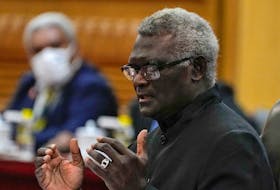Dan Fougere described $90 million in federal funding to help with twinning a stretch of highway through the region as “being like Christmas in July.”
“It is a huge announcement,” the Antigonish Chamber of Commerce president said, describing it as “great news on so many levels.”
During a July 17 visit to northeastern Nova Scotia, Prime Minister Justin Trudeau unveiled the financial boost for the $190-million provincially-led initiative, which will see the twinning of a 38-kilometre stretch of Trans-Canada Highway 104, from Sutherland’s River, Pictou County to Antigonish.
“To see this twinning happen, in a timely fashion, I think a lot of credit goes to both levels of government [ federal and provincial],” Warden Owen McCarron of the Municipality of the County of Antigonish said, calling the federal monies a “huge contribution.”
Trudeau, accompanied by Nova Scotia Premier Stephen McNeil and Central Nova MP Sean Fraser, made the announcement at East Pictou Middle School, which is nestled along a section of the roadway that will be twinned.
“Not only will this project alleviate the bottle neck and get more vehicles moving, but most importantly it will reduce the risk of fatalities along this highway by 80 per cent,” the PM said during his remarks.
Trudeau also singled out Chief Joe MacDonald of the Barney’s River Volunteer Fire Department, who has spearheaded an ongoing push for twinning of that stretch.
“Thank you for your dedication; you can and should be proud,” he told MacDonald.
McNeil said Nova Scotians want the provincial government “to improve the safety of our roads and we are committed to doing just that.”
“Highway 104 is an essential piece of infrastructure connecting communities in our province and our province to the rest of the country.
“I am pleased our federal partners are working with us on this project that will make the highway safer and create jobs,” he added.
Safety is ‘paramount’
Both Fougere and McCarron used the word ‘paramount,’ when talking about the safety benefits that will result from the twinning project.
“Police, fire and emergency service workers have been called to this stretch of highway on far too many occasions,” Fougere said.
Like Trudeau, they praised MacDonald for his tireless effort in helping make this initiative happen.
“He really had the vision and the enthusiasm to continue to push for all the first responders who, unfortunately, have to go out and see some of the accidents that happen along the stretch,” McCarron said.
He called the project a “welcome relief” for the region.
Fougere described MacDonald’s dedication as “yeoman’s work.”
Economic spinoff
Reiterating safety is the main – and most important – benefit, the Antigonish officials also talked about the economic gains that will come from the multi-million dollar initiative.
“The spinoff for the construction phase will be huge for this area – a lot of construction jobs and spinoff for getting goods and services moved in and out of our area, safely, is huge,” McCarron said.
“When we look at tourism – the opportunity for tourists to travel into our region – feeling safe – will be huge for the area.”
Fougere agreed.
“Tourism is an ever-increasing contributor to our local economy and visitors to Cape Breton and our area will finally travel on the safe and efficient highways they want and deserve,” he said.
Fougere added “a capital project of this magnitude, during the construction period, will create many direct and indirect jobs for our trades, service and retail sectors.”
He added the twinned highway will improve links with the other Atlantic Provinces – not only for Antigonish, but also the industrial hub in the Strait area.
“This section of highway is a major thoroughfare between Halifax and Cape Breton Island, and as far as the Newfoundland ferry links,” he said.
Fougere also noted there will be “an absence of tolls,” along the stretch.
“It means that the cost of this project will not fall disproportionately on the shoulders of local users of Highway 104,” he said.
The timeline
The twinning project will include a 10-kilometre, four-lane alignment between Barney’s River and James River, south of the existing Highway 104.
The topography and terrain of the area, as well as a river and rail line, necessitate that new configuration.
Provincial officials estimate construction will begin in early 2020, with the goal to have that portion of Highway 104 twinned by 2024.
McNeil said the twinning project will be constructed using a public-private sector model. He noted there are some opponents to this approach, but added “it was straight and simple for us.”
“It was about saving lives,” he added.
With notes from Adam MacInnis, The News









